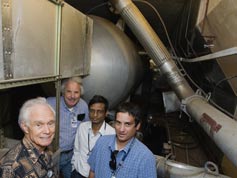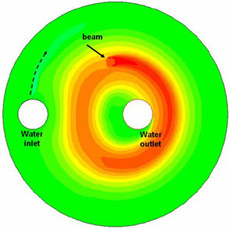
Handy Links
SLAC News Center
SLAC Today
- Subscribe
- Archives: Feb 2006-May 20, 2011
- Archives: May 23, 2011 and later
- Submit Feedback or Story Ideas
- About SLAC Today
SLAC News
Lab News
- Interactions
- Lightsources.org
- ILC NewsLine
- Int'l Science Grid This Week
- Fermilab Today
- Berkeley Lab News
- @brookhaven TODAY
- DOE Pulse
- CERN Courier
- DESY inForm
- US / LHC
SLAC Links
- Emergency
- Safety
- Policy Repository
- Site Entry Form

- Site Maps
- M & O Review
- Computing Status & Calendar
- SLAC Colloquium
- SLACspeak
- SLACspace
- SLAC Logo
- Café Menu
- Flea Market
- Web E-mail
- Marguerite Shuttle
- Discount Commuter Passes
-
Award Reporting Form
- SPIRES
- SciDoc
- Activity Groups
- Library
Stanford
Around the Bay
The World's Biggest Catcher's Mitt
 For all the esoteric complexity involved in accelerator-based science, one simple thing remains true with accelerated particles: they must at some point be stopped. Now, a new international collaboration at SLAC is tackling the problem of how to stop powerful beams produced by accelerators of the future.
For all the esoteric complexity involved in accelerator-based science, one simple thing remains true with accelerated particles: they must at some point be stopped. Now, a new international collaboration at SLAC is tackling the problem of how to stop powerful beams produced by accelerators of the future.
Currently, electrons from SLAC's linac are stopped using a device called a beam dump, which catches the energetic particles in a swirling bath of water. Although beam dumps come in a variety of designs—passive water-cooled metal plates, drums filled with aluminum beads or just a large tank of water—they all have the same function: stopping a beam of particles and dissipating its energy.
But the more powerful the accelerator, the more energetic the beam to be stopped and the bigger and more complex the beam dump must be for handling its beam. Future accelerator designs, which call for beams up to 20 times as powerful as those produced by SLAC's linac, will require specially designed beam dump systems that can safely handle up to 20 megawatts of power. This complex water-flow dump would have to remove in just a few meters all the beam energy attained from an accelerator several kilometers long.
 "These devices are expensive, they are potential radiation sources, they're under the ground, they are full of water, they vibrate and you can't go near them once they're in use," said SLAC physicist Ray Arnold. "But the electrons have to be stopped. Basically we're taking 40 years of work, and pushing it by a factor of 10 or 15 in power."
"These devices are expensive, they are potential radiation sources, they're under the ground, they are full of water, they vibrate and you can't go near them once they're in use," said SLAC physicist Ray Arnold. "But the electrons have to be stopped. Basically we're taking 40 years of work, and pushing it by a factor of 10 or 15 in power."
Last January, Satyamurthy Polepalle of India's Bhabha Atomic Research Centre (BARC) came to SLAC to join the collaboration addressing future accelerator beam dump design, which was the result of the memorandum of understanding between U.S. and Indian universities and laboratories signed in December 2007. Satyamurthy brings to the collaboration years of experience working with proton beams, and says that his three-month stay at SLAC has resulted in a very fruitful exchange of ideas and will continue through this year and beyond.
"Together with SLAC colleagues and with the help of my design team back at BARC, we've been able to fine tune the system parameters based on both the first principle estimations and also complex fluid dynamics studies," said Satyamurthy. "We've made quite good progress during this period and identified the plan of work for the nearest future. It is proposed to continue this collaboration for eventual development of the multi-MW beam dump design."
—Brad Plummer, SLAC Today, March 20, 2008
Top image: (From left) Dieter Walz, Ray Arnold, Satyamurthy Polepalle and John Amann, below ground next to SLAC's main beam dump (round tank in the background).
Bottom image: Temperature contours of water extracting the beam energy in the middle of the beam dump, calculated by the BARC team with use of computational fluid dynamics codes. The color range of green to orange corresponds to a temperature increase of 30 degrees Celsius. (Click on image for larger version.)